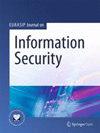Estimating Previous Quantization Factors on Multiple JPEG Compressed Images
IF 2.5
Q2 COMPUTER SCIENCE, INFORMATION SYSTEMS
引用次数: 4
Abstract
The JPEG compression algorithm has proven to be efficient in saving storage and preserving image quality thus becoming extremely popular. On the other hand, the overall process leaves traces into encoded signals which are typically exploited for forensic purposes: for instance, the compression parameters of the acquisition device (or editing software) could be inferred. To this aim, in this paper a novel technique to estimate “previous” JPEG quantization factors on images compressed multiple times, in the aligned case by analyzing statistical traces hidden on Discrete Cosine Transform (DCT) histograms is exploited. Experimental results on double, triple and quadruple compressed images, demonstrate the effectiveness of the proposed technique while unveiling further interesting insights.多JPEG压缩图像前量化因子估计
JPEG压缩算法已被证明在节省存储空间和保持图像质量方面非常有效,因此非常受欢迎。另一方面,整个过程在编码信号中留下痕迹,这些信号通常被用于取证目的:例如,可以推断出采集设备(或编辑软件)的压缩参数。为此,本文提出了一种新的技术,通过分析隐藏在离散余弦变换(DCT)直方图上的统计痕迹,对多次压缩后的图像估计“先前”JPEG量化因子。双压缩、三压缩和四压缩图像的实验结果证明了所提出技术的有效性,同时揭示了进一步有趣的见解。
本文章由计算机程序翻译,如有差异,请以英文原文为准。
求助全文
约1分钟内获得全文
求助全文
来源期刊

EURASIP Journal on Information Security
COMPUTER SCIENCE, INFORMATION SYSTEMS-
CiteScore
8.80
自引率
0.00%
发文量
6
审稿时长
13 weeks
期刊介绍:
The overall goal of the EURASIP Journal on Information Security, sponsored by the European Association for Signal Processing (EURASIP), is to bring together researchers and practitioners dealing with the general field of information security, with a particular emphasis on the use of signal processing tools in adversarial environments. As such, it addresses all works whereby security is achieved through a combination of techniques from cryptography, computer security, machine learning and multimedia signal processing. Application domains lie, for example, in secure storage, retrieval and tracking of multimedia data, secure outsourcing of computations, forgery detection of multimedia data, or secure use of biometrics. The journal also welcomes survey papers that give the reader a gentle introduction to one of the topics covered as well as papers that report large-scale experimental evaluations of existing techniques. Pure cryptographic papers are outside the scope of the journal. Topics relevant to the journal include, but are not limited to: • Multimedia security primitives (such digital watermarking, perceptual hashing, multimedia authentictaion) • Steganography and Steganalysis • Fingerprinting and traitor tracing • Joint signal processing and encryption, signal processing in the encrypted domain, applied cryptography • Biometrics (fusion, multimodal biometrics, protocols, security issues) • Digital forensics • Multimedia signal processing approaches tailored towards adversarial environments • Machine learning in adversarial environments • Digital Rights Management • Network security (such as physical layer security, intrusion detection) • Hardware security, Physical Unclonable Functions • Privacy-Enhancing Technologies for multimedia data • Private data analysis, security in outsourced computations, cloud privacy
 求助内容:
求助内容: 应助结果提醒方式:
应助结果提醒方式:


